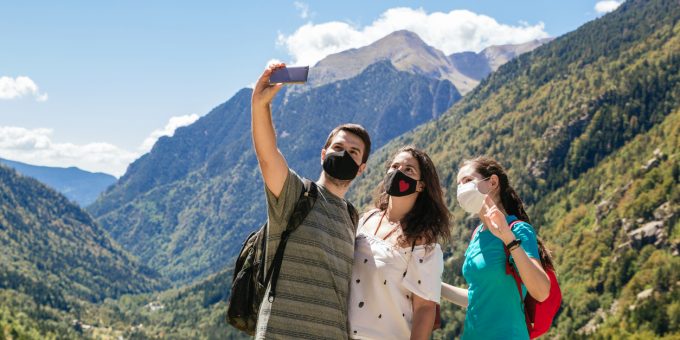
iStockPhoto.com // Adrian Vidal
Distinction Through Distancing
“Just recently martial arts has opened up, wearing masks and staying six feet away,” teenager Ryan told us. It was May 2020, the height of the COVID-19 pandemic in the United States. Despite widespread social distancing measures, Ryan explained that it hadn’t been so difficult to continue to stay active and participate in his favorite activities with friends.
Ryan’s mother, Nicole, was clearly proud of her son’s adherence to social distancing guidelines. She was also proud of how her neighbors in the relatively wealthy and liberal community of Greenville had responded to the crisis. Nicole contrasted her neighborhood’s response to that of a neighboring, more rural and conservative county, which she said had “twice as many deaths and about three times as many cases.” She credited Greenville’s lower mortality rate and COVID case count to its citizens’ responsible behavior, celebrating the fact that Greenville was “taking this seriously and being more responsible around it.”
Praise for the community’s response to the pandemic was common among the 38 parents and teenagers we interviewed in the early months of the COVID-19 pandemic. Our respondents lived in Greenville and Springfield, two affluent, mid-sized cities in the Mountain West. Both towns are predominantly White and liberal, with a strong outdoor recreation culture. As we wrote in a recent article published in Social Science & Medicine, access to economic and geographic resources facilitated community members’ adherence to social distancing guidelines. However, residents often interpreted their ability to distance as proof of their superior intellect or morality, especially in relation to residents of the less affluent, more politically conservative rural counties around them. As a result, pandemic distancing practices became associated with—and ultimately exacerbated—pre-existing social divides.
Although residents of Greenville and Springfield certainly experienced challenges during the early months of the pandemic, multiple factors eased their adoption of social distancing practices. Many of our respondents had jobs that allowed remote work. They typically lived in spacious homes, had abundant access to outdoor space, and owned expensive outdoor recreation gear. Prioritizing time outdoors and physical activity has long been a feature of the local culture, so many of our respondents’ pre-pandemic hobbies were easily adapted to comply with social distancing expectations. Indeed, nearly all the parents we talked to mentioned family members taking advantage of these conditions by going on walks, riding bikes, or jogging. In short, we found that residents’ socioeconomic resources and longstanding outdoor culture made adhering to social distancing guidelines relatively easy.
As the pandemic progressed, distancing practices took on moral significance. Our respondents described social distancing as respectful, responsible, and “the right thing” to do. In interviews, people spoke favorably of others who observed distancing practices and—like Nicole—expressed pride in the conscientious response of the community writ large. Social distancing thus became an identity marker and a source of social status, publicly signaling moral virtue and community membership.When interviewees praised their community’s response to the pandemic, they typically did so by contrasting their own responsible behavior with that of others who, they asserted, did not practice careful social distancing. Although respondents were often quick to make exceptions for members of their own community—for example, teenage children participating in locally-valued sports activities in close proximity without masking—community outsiders were judged more harshly. For example, when asked about others’ distancing practices, a mother named Christine said, “It’s been great in our really close community, but out in the larger world, no. We see a lot of people not following the rules at all.” When asked if these differences fell along social class lines, she explained:
I think it largely is a “what news you consume” divide. …There’s a giant Venn diagram of the people who are like, “Our freedoms are more important than old people dying,” and Fox News watchers, and Trump supporters. …Are you reading the Washington Post and The New York Times? Or are you reading just Fox? …I’m sure that falls along education lines, and I’m sure that follows class lines.
Another mother named Amanda made a similar point, attributing others’ irresponsible behavior to “the MAGA [Make America Great Again] factor.” She explained, “The dummy in Costco is like, ‘You’re endangering my civil liberties.’ It’s like, are you kidding me?” Through statements like these, participants used social distancing practices to reinforce moral and social boundaries between members of their own community and outsiders.
Our discussions with Greenville and Springfield residents illuminate how class-privileged individuals adapted to changing social conditions by using new behaviors to draw moral and social boundaries. Ignoring the economic and geographic resources that facilitated their “responsible” behavior, residents preferred instead to interpret their community’s social distancing response as a reflection of its moral superiority. This narrative is concerning because it subtly legitimizes existing status hierarchies and lends fuel to the growing political divide. As social conditions change, it is critical to examine how individuals ascribe meaning to new social behaviors and consider how their narratives may justify and reinforce existing social hierarchies.
Katie Mercer is a doctoral student in the Department of Sociology at the University of Colorado-Boulder. She studies gender, sexualities, and health. Stefanie Mollborn is in the Department of Sociology at Stockholm University in Sweden. She studies health and well-being among young people and families in the United States and Europe.

Comments